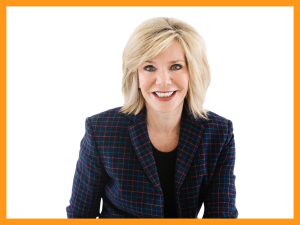
In 2023, for the first time in history, women CEOs lead about 10% of Fortune 500 companies. This is undoubtedly an important milestone. But it also underscores the need for more women at all levels of leadership.
And this is not just about representation. Women leaders are good for business:
- The Ready-Now Leaders report from the Conference Board shows that organizations with at least 30% women in leadership roles are 12x more likely to be in the top 20% for financial performance.
- Research from Leadership Circle, based on assessments with over 84,000+ leaders and 1.5 million raters (comprising boss, boss’s boss, peers, direct reports, and others), shows that female leaders show up more effectively than their male counterparts across every management level and age level.
 Creating a pipeline for women leaders is a business issue. IBM’s report this year states that “Women remain acutely underrepresented in the middle management tiers, jeopardizing prospects for a healthy pipeline of future women leaders.” So, how can you best develop a pipeline of female leaders to drive equitability and bottom-line results?
Creating a pipeline for women leaders is a business issue. IBM’s report this year states that “Women remain acutely underrepresented in the middle management tiers, jeopardizing prospects for a healthy pipeline of future women leaders.” So, how can you best develop a pipeline of female leaders to drive equitability and bottom-line results?
First, it helps to understand what exactly makes women more effective leaders. And who could better break down the research than Cindy Adams, President and CLO at Leadership Circle? Adams was at the helm of Leadership Circle’s new study, which offers insights into the differences in leadership impact between male and female leaders. She is passionate about using this data to help women advance in leadership roles.

The Feminine Leadership Advantage—How Women Outscore Men In Leadership Effectiveness
The research that Adams led at Leadership Circle is from the Leadership Circle Profile, a scientifically validated 360-degree assessment of leadership that measures “Creative Competencies” and “Reactive Tendencies.”
“Creative leaders’ behaviors flow from their values and purpose,” Adams said, “rather than from a set of assumptions about how leaders are supposed to behave.” Creative Competencies are highly researched and validated effective leadership competencies around the world. These include competencies that scale across five dimensions:
- Relating
- Self-awareness
- Authenticity
- Systems Awareness
- Achieving
Reactive Tendencies, on the other hand, are tendencies that “got us here, but won’t get us there,” Adams said. “The reactive structure of ‘beliefs and assumptions’ are designed to keep us safe or to protect a sense of worth. But, they contain self-limiting beliefs and behaviors that hold leaders back from achieving their full potential.” Reactive leaders rely heavily on early life scripts of what leaders are supposed to do and say, which often leads to autocratic micromanaging. The three reactive dimensions include:
- Complying
- Protecting
- Controlling
Based on Leadership Circle’s growing database of more than 240,000 complete leadership profiles, Adams highlighted three key advantages that research indicates contribute to female leaders being more effective than male leaders.
- Women score significantly higher on all five Creative Dimensions: Women leaders score significantly higher in their capability to “connect and relate to others,” as well as in the Authenticity and Systems Awareness competencies. This suggests that women leaders are not only better at building relationships but also that the relationships they build are characterized by authenticity and an awareness of how they contribute to “the greater good beyond the leader’s immediate sphere of influence.”
- Women are more likely to lead from a Creative mindset and “play for all to win”: Adams wrote, “Female leaders more often lead from a ‘playing to win’ orientation—focusing on their natural curiosities about what matters most to the future they are creating and partnering with others to move toward that vision. Male leaders can and do also lead from this orientation, but they are just as likely to lead from a ‘play not to lose’ orientation and may spend as much time moving away from what they don’t want as moving toward what they do.”
- Women build and cultivate stronger connections: Adams said, “Female leaders show up in a noticeably different way than male leaders in terms of building caring connections, mentoring and developing others, and exhibiting concern for the community. In today’s business environment, this acts as a superpower.”
“In a nutshell,” Adams said, “female leaders demonstrate higher levels of leadership effectiveness and higher levels of Creative competency (in all dimensions), and they demonstrate lower Reactive impact compared to their male counterparts.”
Despite all the measurable benefits female leaders bring to organizations, many still do not effectively develop and support them.
How To Develop Women Leaders To Harness the Feminine Leadership Advantage
“If you’re not forging a path in your company to make leadership more inclusive or leveraging the full power and potential of women in leadership, then you’re not doing all you can for the success of your organization.”
—Cindy Adams, chief learning officer at Leadership Circle
To harness the feminine leadership advantage, Adams points out that simply hiring more women isn’t enough.
“Diversity in leadership ranks is proven to have a strategic advantage,” Adams emphasized. “It’s important to not only hire and promote female leaders but to encourage their development early and to help them gain as much business experience and knowledge as they can in roles that may still be male-dominated.”
Perhaps the single best way to develop a strong pipeline of female leaders is to build a Women in Leadership program. What follows are four key elements to enable a successful program.
- Focus on “Authentic Self-Advocacy.”
Leadership Circle’s data reveals that, despite female leaders showing up more effectively than male leaders, they underestimate their skills and influence to a greater extent than male leaders. Female leaders are also “overloaded and overcommitted” to a higher degree than their male counterparts.
To Adams, this points to the need for women to learn how to see themselves authentically and to learn how to talk about their strengths and advocate for themselves. For example, the first several months of Adobe’s women-in-leadership training program focus on personal leadership practices intended to empower up-and-coming women leaders. Participants explore questions like:
- What are your superpowers? What are your unique talents and strengths? How can you amplify them and bring them to the organization?
- What are your values?
- Who can be on your personal board of directors to support your success?
- How can you maximize your time for greater impact?
Emphasis on authentic self-advocacy helps narrow the gap between women’s measurable effectiveness and their self-perception.
- Lean on Cohort-Based Learning and Peer Learning.
Learning is much more likely to “stick” when it happens in a community of like-minded people. Adobe’s program, for example, leverages “Mastermind” groups of four to six women participants, in which they can peer coach and dive deeper into what they’re learning. Cohort-based learning emphasizes networking and relationship-building, which are especially vital in remote and hybrid work environments. A cohort-based approach can help create an ongoing network of support that extends far beyond the period of your program.
- Leverage Executive Coaches To Personalize Growth and Support.
In a one-on-one coaching relationship, women leaders can get personalized support as they navigate their growth and development. The pharmaceutical company Endo prioritizes coaching in its “ASPIRE” program for women in leadership. “I've seen the power of pairing strong female talent with strong female coaches,” said Patrick Barry, EVP and president of global commercial operations at Endo. “So, I helped build ASPIRE to formalize the pairing of female talent with coaches.”
Similarly, Adobe weaves executive coaching into the fabric of its women-in-leadership program. At Adobe, executive coaches are involved not only as one-on-one support for participants but also in conversations with participants’ managers. This helps deepen the coaches’ impact and involve the participants’ managers more directly.
- Bridge the “Knowing-Doing Gap” with Application Exercises and Manager Engagement.
Providing leaders opportunities to practice, experiment, and apply new beliefs and skills is the best way to translate “learning” into “doing.”
At Adobe, participants move into breakout groups immediately after a new concept has been introduced. Breakout sessions offer participants the opportunity to reflect and discuss how they’ll put new learnings into practice and answer questions like:
- How will I use this concept?
- What will it look like?
- What questions do I have?
Adobe is also intentional about engaging participants’ managers in the process. “We ask the participants to give monthly updates to their managers and share what they learned, how they can apply it, and how their manager can help,” said Angela Szymusiak, director of DE&I talent development at Adobe. “Encouraging participants to engage their managers throughout this experience helps ground their learning and makes it practical, relevant, and valuable in their day-to-day jobs.”
Start Developing Your Women Leaders NOW
No matter the design, content, or length of a leadership development program, Adams says it’s crucial to start early—for the benefit of future women leaders and the organization at large.
“Women, in particular, make that shift from ‘less effective’ to ‘more effective’ sooner than men,” says Adams. “If we start building more diverse teams and organizations now, businesses will be better for it, and the world will be better for it today and ten years from now.”






